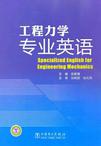工程力学专业英语
出版时间:2011-1 出版社:中国电力出版社 作者:白新理 主编 页数:188
前言
学习完大学英语之后,不少工科专业的本科学生面对本专业的英语教材、英语科技论文都感到无所适从.感觉到自己的英语水平还差得太远。其实,许多工科专业都是以数学和力学为基础的,只要掌握了常用的数学词汇和基本的力学词汇,阅读本专业的英语文献是不成问题的。 本书为高等院校工程力学专业的“专业英语”课程教材。它以工程力学专业教学计划及《工程力学专业英语》教学大纲为指导,兼顾土木、水利、机械等相近专业的需要,是编者在多年专业英语教学实践的基础上编写而成的。全书按单元编排.涵盖了常用的数学词汇及基本的力学词汇。书中主要内容有理论力学、材料力学、结构力学、弹性力学、塑性力学、有限元法、流体力学、土木工程、结构设计、高层建筑、水工结构、建筑材料、项目管理等。书后的附录中列出了常用数学符号的读法及缩略语。 参加本书编写工作的有华北水利水电学院白新理、谢巍、张建华和河南黄河河务局杨志超四位同志。全书由白新理教授担任主编,谢巍、张建华担任副主编。研究生范渊源、于巍、王单飞、王俊峰等同学参加了部分整理工作。 本书由郑州大学孙利民教授及华北水利水电学院孙大风教授担任主审。他们审阅了书稿.并提出了有益的建议和建设性的修改意见。华北水利水电学院杨开云、孟闻远、郑恒祥三位教授也对本书提出了指导性的建议。本书参考了许多文献资料.在此向有关作者、编者一并表示谢意。 由于编者水平有限,再加上时间仓促,书中可能有不少疏漏、不妥,甚至错误之处.恳请读者批评指正。
内容概要
由白新理主编的《工程力学专业英语》按单元编排,涵盖了常用的数学词汇及基本力学词汇,主要内容有理论力学、材料力学、结构力学、弹性力学、塑性力学、有限元法、流体力学、土木工程、结构设计、高层建筑、水工结构、建筑材料、项目管理等。最后,在附录中列出了常用数学符号的读法及缩略语。
《工程力学专业英语》可作为高等院校工程力学专业的“专业英语” 课程教材,也可作为土木工程相关专业学生的参考用书。
书籍目录
前言
Unit One
1 Theoretical Mechanics
2 Conditio for Rigid-Body Equilibrium
3 General P1ane Motion
Unit Two
1 Absolute and Relative Velocity in Plane Motion
2 Itantaneous Center of Rotation in Plane Motion
3 Kinetics(Classical Mechanics)
Unit Three
1 Overview of Engineering Mechanics
2 Stress and Strain
3 Teile Stress-Strain Behavior
Unit Four
1 Toion of a Circular Bar
2 Deflectio of Beams
3 Stability of Structures
Unit Five
l Influence Lines for Bending Moment
2 Force and Deformation Method
3 Moment Distribution Method
Unit Six
1 Dynamics
2 Structural Analysis Methods for Seismic Actio
3 Linear Elastic Fracture Mechanics
Unit Seven
1 Elastics
2 Stress C0ncentratio
3 Elastic Cotitutive Relatio
Unit Eight
1 Plastic Behavior of a Teile Bar
2 Mechanisms of Plastic Deformation
3 Plastic Limit Analysis
Unit Nine
1 Finite Element Method
2 Finite Element Method Programming
3 Soil Mechanics in Foundation Engineering
Unit Ten
1 Introduction to Fluid Mechanics
2 A Brief History of the Development of Fluid Mechanics
3 Basic Equatio of Fluid Mechanics
Unit Eleven
1 Civil Engineering
2 Caree in Civil Engineering
3 Building Types and Design
Unit Twelve
1 Philosophy of Structural Design
2 Strength and Stiffness of Buildings
3 Design of Simple Structures
Unit Thirteen
1 Reinforced Concrete Structures
2 Development of Reinforced Concrete
3 Steel Sructurt
Unit Fourteen
1 Structural Forms of Tall Buildings
2 Bridge Structures
3 Techniques of Bridge Cotruction
Unit Fifteen
1 Hydraulic Structures
2 The Choice of the Type of a Dam
3 Experimental Techniques
Unit Sixteen
1 Building Materials
2 Modern Buildings Design and Structural Materials
3 Future Trends in Cotruction
Unit Seventeen
1 What Is Project Management
2 The Project Life Cycle
3 Civil Engineering Contracts
Unit Eighteen
1 Scientific Paper
2 How to Write a Scientific Paper
3 Some of the Mechanics Scientists
Appendix Ⅰ Pronunciatio of Greek Lette
Appendix Ⅱ Expressio of Mathematical Symbols
Appendix Ⅲ Common Abbreviatio
Appendix Ⅳ Known Abbreviatio of International Civil Engineering
Organizatio
References
章节摘录
computed in the analytical model of the actual structure for the assumed design conditions may or may not be in close agreement with the stress intensities produced in actual structure by the actual conditions to which it is exposed.The degree of correspondence is not important,provided that the computed stress intensities can be interpreted in terms of previous experience.The selection of the service conditions and the allowable stressintensities provides a margin of safety against failure.The selection of the magnitude of this margin depends on the degree of uncertainty regarding loading,analysis,design,materials,and construction and on the consequences of failure.For example,if an allowable tensile stress of 20000 psi is selected for structural steel with a yield stress0f 3 3000 psi,the margin of safety(or factor of safety)provided against tensileyielding is 33 000/20000,or 1.65.5.The allowable-stress approach has an important disadvantage in that it does not providea uniform overload capacity for all parts and all types of structures.As a result,there istoday a rapidly growing tendency to base the design on the ultimate strength and serviceability of the structure,with the order allowable-stress approach serving as analternative basis for design.The newer approach currently goes under the name of strength design in reinforced-concrete design literature and plastic design in steel-designliterature.When proportioning is done on the strength basis,the anticipated serviceloading is first multiplied by a suitable load factor(greater than 1),the magnitude of which depends upon the uncertainty of the loading,the possibility of its changing during the life of the structure,and,for a combination of loadings,the likelihood,frequency,and duration of the particular combination.In this approach for reinforce-concrete design,the theoretical capacity of a structural element is reduced by a capacity-reduction factor to provide for small adverse variations in material strengths,workmanship,and dimensions.The structure is then proportioned so that,depending on the governing conditions,the increased load would:(1)cause a fatigue or a buckling or a brittlefracture failure or;(2)just produce yielding at one internal section or simultaneous yielding at several sections)or;(3)cause elastic plastic displacement of the structure or;(4)cause the entire structure to be on the point of collapse.
图书封面
评论、评分、阅读与下载
用户评论 (总计1条)
- 老师推荐买的,不错!
推荐图书
- 媒介概念十六讲
- 逃げの一手
- 热球时代
- よんでますよ、アザゼルさん。 01
- カムイ伝全集―決定版 (第1部15)
- カムイ伝全集―決定版 (第1部14)
- カムイ伝全集―決定版 (第1部13)
- カムイ伝全集―決定版 (第1部12)
- カムイ伝全集―決定版 (第1部11)
- カムイ伝全集―決定版 (第1部10)
- カムイ伝全集―決定版 (第1部9)
- カムイ伝全集―決定版 (第1部8)
- カムイ伝全集―決定版 (第1部7)
- カムイ伝全集―決定版 (第1部6)
- カムイ伝全集―決定版 (第1部5)
- カムイ伝全集―決定版 (第1部4)
- カムイ伝全集―決定版 (第1部3)
- カムイ伝全集―決定版 (第1部2)
- 艺术品鉴定新探
- 石勒探案3
- 查理九世
- 查理九世
- 亲密关系
- 查理九世
- 查理九世
